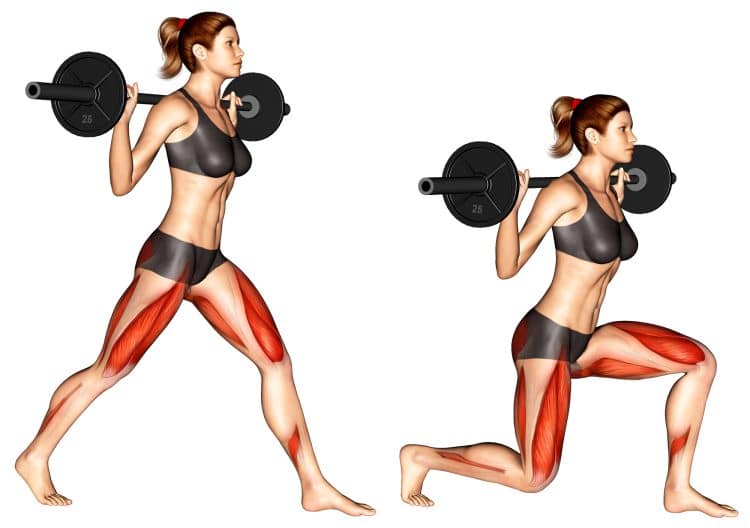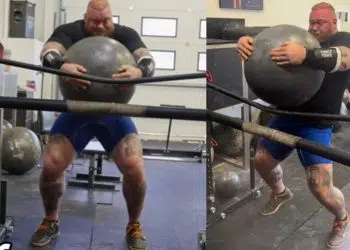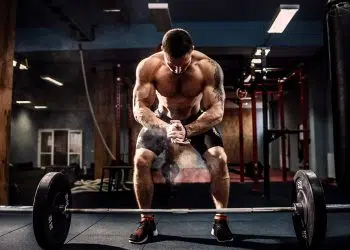A balanced training program incorporates bilateral compound movements, such as squats, deadlifts, and bench presses. Bilateral exercises require both limbs to work at the same time. In these exercises, however, your stronger side might compensate for the weaker limb, leading to muscle and strength imbalances. You must add unilateral exercises to your training program to fix these imbalances.
A unilateral exercise involves working one side of your body at a time. By doing this, you are still working both sides of the body equally [1]. You may be curious as to how both your sides are working if only one side is moving. A theory called cross-education explores how your contralateral muscles on the unworked side are still stimulated during unilateral training [2]. This effect aids in injury prevention and rehabilitation. This is an added benefit to using unilateral patterns in a training program.
One of the best examples of this archetype is the split squat. The split squat mainly targets your quads and glutes. Because it requires more muscular focus, the split squat is great for strengthening athletic movements such as running and jumping.
In addition to rehabilitation and athletic performance, adding unilateral patterns into your training program assists in avoiding overtraining and utilizing your core stabilizer muscles. Read along to learn more about the ins and outs of the unilateral split squat.
What is a Barbell Split Squat?
The split squat fits into the knee-dominant lunge category of exercises. This group of exercises utilizes hip extension and internal rotation. The difference between a lunge and a split squat is movement. Lunges tend to move the feet forward and back—adding a cardio component to the strength exercise. In contrast, a split squat is stationary. To perform a proper split squat—place one leg in front of you and the other behind. Move up and down vertically.
There are two types of split squat progressions—ipsilateral and contralateral. When loading the split squat with a kettlebell or dumbbell, the side you place the weight on determines if it is ipsilateral or contralateral. In an ipsilateral pattern, the load is placed on the same side of the working leg. In the contralateral, the weight is placed on the opposite side of the working leg. These two splits challenge balance when used correctly in a training program. If you struggle with balance, a great way to start a split squat pattern is with the barbell. A barbell split squat keeps the upper body extended. Be aware not to overextend your lower back, as it could lead to injury.
Level Up Your Fitness: Join our 💪 strong community in Fitness Volt Newsletter. Get daily inspiration, expert-backed workouts, nutrition tips, the latest in strength sports, and the support you need to reach your goals. Subscribe for free!
Research has shown that split squats display greater activation from the gluteus medius, gluteus maximus, and hamstrings than a traditional back squat. Making this a great accessory lift to make your squat pattern stronger.
Understanding the difference in biomechanics, how weight can be placed and transferred in this exercise, and the muscles worked allows for more advancement in program design.
Muscles Worked in a Barbell Split Squat

The split squat is a unilateral compound exercise that works multiple muscles in the lower body. If you experience back pain, the split squat is a great option because it unloads your spine, focusing on hip mobility and flexibility. Performing a split squat focuses on the following muscles:
Hamstrings
The hamstrings don’t play a huge role when performing the split squat. They tend to activate at the top of the movement, assisting the hips. To understand this further, let’s look at the hamstring’s function. The hamstring crosses at the knee and hip joint. It controls knee flexion and hip extension. The three parts of the hamstring are [3]:
- Semitendinosus
- Semaimembranosous
- Biceps Femoris
Glutes
The glute is the largest muscle in the human body. During the split squat, the glutes achieve maximal stimulation at the movement’s top. There are two parts of the glute muscles activated during a split squat [4]
- Glute Maximus: functions in hip extension
- Glute Medius: stabilizes the pelvis and maintains the torso upright in single-leg exercises
Quads
The quad plays the main antagonist in the split squat. When performing the split squat, you place about 85% of your weight in your quad. The quads become most activated during the lower position of the split squat [5].
Four heads of the quadricep assist in knee extension, and one head functions in hip flexion.
- Vastus Lateralis
- Vastus Medialis
- Vastus Intermedius
- Rectus Femoris: Knee extension and hip flexion
The great thing about the split squat is that it will place more emphasis on the quads, glutes, or hamstrings based on torso placement.
Abs
Challenging your balance is a great way to activate your core. The side on which the weight is placed determines which part of the abdominals is used. [6]
- External Obliques: Assists in rotation
- Rectus Abdominis: Assist in anterior flexion
Benefits of the Barbell Split Squat
Unilateral training can help most people. For the general population, being balanced aids your everyday life, especially as you get older. For athletes, unilateral patterns like split squats reflect on the field and court, like sprints or lay-ups. Below are some main benefits of adding split squats to your next training program:
Increase core stability
Split squats are the ultimate test of balance and stability. To control the movement, you have to be able to brace your core. Breathing techniques are a great way to learn how to brace your core.
Strengthens your back and shoulders
When you add a barbell to your split squat, you work your back and shoulders to keep your torso upright. When you remove the barbell and add a kettlebell or dumbbell, you lighten the load on your spine. However, you are still working your erector spinae.
Increases hip mobility and flexibility
One of the secondary muscles the split squat works are the hip abductors. These muscles help stabilize the pelvis and trunk. By strengthening these muscles, you increase your range of motion and flexibility of the stabilizer muscles.
Fixes muscle imbalances
Fixing muscle and strength imbalances is one of the main functions of a unilateral exercise. Split squats place your body in a stacked position for specific joint alignment. The ability to train your muscles separately allows you to properly isolate training methods to allow those weaker muscles to catch up.
How to Perform a Barbell Split Squat
Let’s look at the proper way to perform a split squat. You’ll use a barbell for this.
Level Up Your Fitness: Join our 💪 strong community in Fitness Volt Newsletter. Get daily inspiration, expert-backed workouts, nutrition tips, the latest in strength sports, and the support you need to reach your goals. Subscribe for free!
Steps:
- Start in a squat rack. Place the barbell on your upper trap.
- With the barbell on your back, step out from the rack.
- Place your dominant foot in front, about 2-4 feet away from the non-dominant foot.
- Place most of your weight evenly across your front foot. Plant your back toes on the floor with your heel raised.
- Square your hips. Keep your torso upright and core tight.
- Begin the downward movement by bending at the hips and the front knee. The back knee will follow.
- Pause 1-2 inches from the ground. Hold for 1-2 seconds before starting your ascent.
- Push through the front quad and back glute to assist.
Pro Tips
- The number one pro tip is always to have a spotter when performing any exercise with a barbell.
- Keep the weight light if you start with the barbell. The bar should sit comfortably on your upper traps and shoulders.
- Practice your stance before adding weight. You don’t want to be figuring out your foot placement with weight on your back.
- You can start with either foot. Your dominant foot will make you feel more comfortable as you get used to the movement.
- If you cannot hold an upright position, the weight may be too heavy, or you’re not engaging your core throughout the entire movement.
- If you lose your balance on the descent, stop, bring yourself back to a bilateral stance, and reposition your split stance.
- Make sure that your hip is always over your back knee. If it is not, your stance is too wide.
- Don’t touch your knee on the ground. You could injure your kneecap by banging it on the floor.
- Be aware of how your knees are tracking. Your knees should never be over your toes.
In This Exercise:
- Target muscles group: Quads, Glutes, and Hamstrings
- Secondary muscles: Hip Abductors and Abs
- Type: Strength
- Mechanics: Unilateral
- Equipment: Barbell
- Difficulty: Intermediate and advanced
- Reps: 8-12
- Sets: 3-4
Common Mistakes in the Barbell Split Squat
Here are the most prevalent barbell split squat mistakes:
Improper Base
You must check your form if you can’t perform the split squat with a full range of motion. Are your knees over your toes? Is your back upright? Your feet are too close together if your front heel elevates at the bottom.
The best way to determine your split stance is to slide your foot behind you. Drop your knee to the ground. Wherever your knee stacks under your hip with your knee in line with your toes is the correct stance.
Loss of Balance
The point of the split squat is to challenge your balance, but not to a point where you can’t perform the exercise. There could be several reasons why you are losing balance. The weight you are using could be too heavy. You might not have planted that back toe properly for the heel to be high enough. Your stance could be too narrow.
Core not engaged
This is the most common barbell split squat mistake. You will not perform this movement properly if your core is not engaged. If your spine is loaded as it is in the barbell split squat, you must engage your core throughout the entire movement, or your lower back will compensate. Keep your chest up and your head and shoulders stacked. You could lean slightly depending on what muscle you’re trying to engage (look back at the muscles worked section).
Can’t bailout
For safety, you should have a spotter when performing any barbell exercise. The bailout is often overlooked if you don’t have a spotter. Anything can happen in the gym. The best thing to do is to know how to safely let go of a bar in an emergency. If you cannot reach the squat rack and need to bail out on the weight, let the barbell fall behind you as you jump forward.
Variations and Alternatives to Barbell Split Squat
There are so many unilateral patterns that will help strengthen your barbell split squat. From beginners to advanced, there is something in here for everyone. All exercises can be done using body weight, dumbbells, kettlebells, or barbells.
1. Prisoner Split Squat
This is the best way to start with balance in the split stance pose for beginners. The arms behind your head allow you to keep your torso and chest upright. Use a foam pad to use as a mobility placement point.
Steps:
- If using a foam pad, place one foot in front and the other behind so the pad is in the middle of your stance. If you are not using a pad, place yourself in your split stance.
- Place your hands on the back of your head.
- Perform the split squat the same as you would with weight.
- Focus on your back toe and heel position, your front and back knee stacking, and your core remaining engaged.
Pro Tip: If you find yourself overextending your back with your hands behind you, bring them to the front of your chest or out to the sides.
2. Front-Foot Elevated Split Squat
When you change the angle of your split squat, you change the percentage of muscle engagement. The front-foot elevated split squat is an example of this. Placing a small box or 45-pound plate in front of you will engage your hamstrings 1-4% more than the regular split squat.
Steps:
- Place your foot on a 6” box or 45-pound plate.
- Get yourself in a forward lunge position, keeping your shoulder, hip, and knee stacked.
- Drop down into your split squat.
Pro Tip: You can do this with a barbell, dumbbell, or kettlebell. It’s better not to use a box or step higher than 6 inches.
3. TRX Rear-Elevated Split Squat
This is a great progression for beginners. If you’re uncomfortable adding weight to your split squat, challenge your balance and core with the TRX. This exercise focuses entirely on the supporting leg.
Steps:
- Adjust your TRX, so it is about 4-6” inches from the ground.
- Face away from the TRX and place your back foot into the strap. The strap should sit comfortably on your midfoot.
- Begin the descending movement by bending your front leg. Bring the TRX support leg back simultaneously until you feel a stretch in your hip flexors.
Pro Tip: If the rear foot is still challenging, turn around and hold the TRX in your hands. Perform the regular split squat. It will still challenge your core and balance.
4. Bulgarian Split Squat
The Bulgarian split or rear-elevated split squat is the most popular progression of the barbell split squat is the Bulgarian split or rear-elevated split squat. This movement is for more intermediate to advanced lifters. It requires more balance, core, quad, and glute strength.
Steps:
- Find a bench, 4-6” box, or squat rack roller to elevate your back foot.
- Your front foot should be about 2-4 feet in front of your bench.
- The majority of your weight should be on the front foot.
- Your torso should remain upright, not leaning forward.
- Descend into your split squat.
Pro Tip: This exercise can be advanced by holding dumbbells on your sides, placing a barbell on your back, in the front, or using a taller box as your mobility improves.
5. Staggered RDL
Switching the movements from knee dominant to unilateral hip dominant is a great option. This exercise will engage your glutes and hamstring more, making the split squat a more powerful exercise in your arsenal.
Steps:
- Stand with your feet in a staggered stance hip-width apart
- Place your back toes on the floor, and lift your heel.
- Bend both of your knees slightly. Your back knee should have more of a bend than your front knee.
- Bend at the hips, push your butt back, and keep your spine neutral.
- Lower your torso as far as you can without bending your knees anymore or until you feel a stretch in the front hamstring.
- Use your hamstrings and glutes to push your hips forward and stand up.
Pro Tip: This is an advanced movement. Best to try if you are familiar with a bilateral RDL. If this feels challenging and you have better balance, try a single-leg RDL.
FAQs
Can I make split squats plyometric?
Of course, you can! If you feel confident in your split squat’s stability and strength, add a jump or a tempo. You can vary your plyometrics by jumping off both feet, elevating your back foot and jumping off your front foot, or adding a pulse or hold at the bottom of your split squat.
Are split squats good for you after an injury?
This study was conducted on muscle activity in back squats vs. rear elevated split squats vs. split squats [8]. Bilateral back squats are traditionally used to build lower body strength in athletes and the general population. However, It has been recently suggested that rear-elevated split squats place less comprehensive force on the lower back while emphasizing the hips and stabilizers. In another study, Electromyographic (EMG) was conducted on elite female athletes. EMG activity showed that single-leg squats recruit higher levels of the bicep femoris and glute medius. This greater hamstring recruitment helped with knee stabilization [9]. Both studies suggest that unilateral squat variations can help with rehabilitation.
Wrap Up
The split squat is a great variation to amp up your training program. It helps build balance, core strength, and muscle mass, focuses on lower body strength and athleticism, and comes with many variations, alternatives, and progressions for all skill levels. The barbell split squat, in particular, is an excellent supplement for the bilateral squat or a compound movement day.
References
- Burke K. Colostate.edu. Published April 30, 2019. Accessed February 15, 2023.
- Lepley LK, Palmieri-Smith RM. Cross-education strength and activation after eccentric exercise. J Athl Train. 2014 Sep-Oct;49(5):582-9. doi: 10.4085/1062-6050-49.3.24. Epub 2014 Aug 12. PMID: 25117873; PMCID: PMC4208861.
- Eldridge, Alison. “hamstring”. Encyclopedia Britannica, 14 Oct. 2022
- Britannica, The Editors of Encyclopaedia. “gluteus muscle”. Encyclopedia Britannica, 16 Nov. 2018.
- Britannica, The Editors of Encyclopaedia. “quadriceps femoris muscle”. Encyclopedia Britannica, 1 Mar. 2023.
- Britannica, The Editors of Encyclopaedia. “abdominal muscle”. Encyclopedia Britannica, 18 May. 2020.
- DeFOREST BA, Cantrell GS, Schilling BK. Muscle Activity in Single- vs. Double-Leg Squats. Int J Exerc Sci. 2014 Oct 1;7(4):302-310. PMID: 27182408; PMCID: PMC4831851.
- McCurdy K, O’Kelley E, Kutz M, Langford G, Ernest J, Torres M. Comparison of lower extremity EMG between the 2-leg squat and modified single-leg squat in female athletes. J Sport Rehabil. 2010;19(1):57–70.
Interested in measuring your progress? Check out our strength standards for Bench Press, Bulgarian Split Squat, Deadlift, and more.











